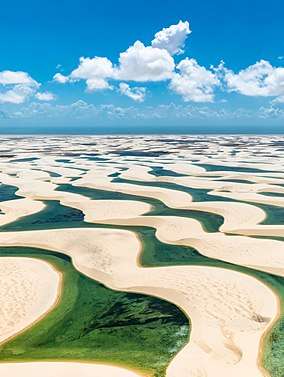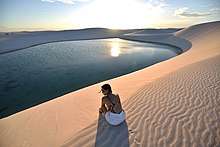Lençóis Maranhenses National Park
Lençóis Maranhenses National Park (Parque Nacional dos Lençóis Maranhenses[lower-alpha 1]) is a national park located in Maranhão state in northeastern Brazil, just east of the Baía de São José. Protected on June 2, 1981, the 155,000 ha (380,000-acre) park includes 70 km (43 mi) of coastline, and an interior composed of rolling sand dunes. During the rainy season, the valleys among the dunes fill with freshwater lagoons, prevented from draining due to the impermeable rock beneath. The park is home to a range of species, including four listed as endangered, and has become a popular destination for ecotourists.
| Lençóis Maranhenses National Park | |
|---|---|
IUCN category II (national park) | |
 | |
 | |
| Location | Northeastern Maranhão, Brazil |
| Coordinates | 02°32′S 43°07′W |
| Area | 155,000 hectares (380,000 acres).[1] |
| Designation | National park |
| Created | June 2, 1981[2] |
| Governing body | IBAMA |
Physical geography
The park is located on the northeastern coast of Brazil in the state of Maranhão along the eastern coast, bordered by 70 kilometres (43 mi) of beaches along Atlantic Ocean.[4][5]:80 Inland, it is bordered by the Parnaíba River, the São José Basin, and the rivers of Itapecuru, Munim, and Periá.[5]:80 The park encompasses an area of 155,000 hectares (380,000 acres), composed mainly of expansive coastal dune fields (composed of barchanoid dunes), which formed during the late Quaternary period.[1][5]:79
While much of the park has the appearance of a desert, the area receives about 1,200 millimetres (47 in) of rain per year, while deserts, by definition, receive less than 250 millimetres (10 in) annually.[3] About 70% of this rainfall occurs between the months of January and May.[4]
The sand is carried to the park from the interior of the continent by the Parnaíba and Preguiças rivers, where it is then driven back inland up to 50 kilometres (31 mi) by winds, creating a series of sand dunes rising as much as 40 metres (130 ft) tall.[3] During the rainy season, between the months of January and June, the rainstorms fill the spaces among the dunes with fresh water lagoons of up to 100 metres (330 ft) in length and 3 metres (10 ft) in depth, and together comprising as much as 41% of the area of the park.[4][6] The water in the lagoons is prevented from draining by a layer of impermeable rock located beneath the sandy surface.[2] The lagoons typically have a temperature between 27.5 °C (81.5 °F) and 32 °C (90 °F), pH of between 4.9 and 6.2, and low levels of dissolved nutrients.[7] When the dry season returns, the pools quickly evaporate, losing as much as 1 metre (3 ft) of depth per month.[6]
In the interior of the park are located two oases or restingas, Queimada do Britos, covering an area of 1,100 hectares (2,700 acres), and Baixa Grande, covering an area of 850 hectares (2,100 acres).[4]
The area of the park has an average annual temperature of between 26 °C (79 °F) and 28.5 °C (83.3 °F) and an annual temperature variation of about 1.1 °C (2 °F).[4][7]
Ecology
The lagoons in the park are often interconnected with one another, as well as with the rivers that run through the area. They are home to a number of fish and insect species, including the wolf fish, which burrows down into wet layers of mud and remains dormant during the dry season.[6][3] Besides the dunes that form the centerpiece of the park, the ecosystem also includes area of restinga and mangrove ecosystems.[2]
The park is home to four species listed on the Brazilian List of Endangered Species, the scarlet ibis (Eudocimus ruber), the neotropical otter (Lontra longicaudis), the oncilla (Leopardus tigrinus) and the West Indian manatee (Trichechus manatus).[2] The park also includes 133 species of plants, 112 species of birds, and at least 42 species of reptiles.[2][4]
Tourism

Lençóis Maranhenses National Park receives as many as 60,000 visitors a year, and is a popular destination for ecotourism, given its unique physical features.[3][5]:80 Common activities within the park include "night sky observation, surfing, bicycle touring, canoeing, ecotourism, adventure tourism, rustic camping, horseback riding, and all-terrain vehicle...and water tours."[5]:80 The best route of entry is flight to the regional capital of São Luís, and then travel by jeep to the interior of the park from Barreirinhas.[6]
In popular culture
The park was featured in the Brazilian film The House of Sand. Kadhal Anukkal, a song from an Indian Tamil language film Enthiran starring Rajnikanth and Aishwarya Rai Bachchan was also shot here.[8][9] The films Avengers: Infinity War (2018) and Avengers: Endgame (2019) used the park's landscape as the planet of Vormir.[10]
See also
- Genipabu
- Conservation in Brazil
- List of national parks of Brazil
Notes
- Literally the "bedsheets of Maranhão"[3]
References
- Strutner, Suzy. "Lençóis Maranhenses Is A Magical Desert-Like Wonderland". The Huffington Post. Retrieved 5 August 2018.
- "Parque Nacional dos Lençóis Maranhenses – Lençóis Maranhenses National Park". UNESCO. Retrieved 6 August 2018.
- Ribeiro, Ronaldo (2010). "A Sea of Dunes". National Geographic. Retrieved 24 August 2018.
- Miranda, Jivanildo; Lopes Costa, João Carlos; Duarte da Rocha, Carlos Frederico (29 November 2012). "Reptiles from Lençóis Maranhenses National Park, Maranhão, northeastern Brazil". ZooKeys (246): 51–68. doi:10.3897/zookeys.246.2593. PMC 3520146. PMID 23275751.
- Vieira, Bianca Carvalho; Salgado, André Augusto Rodrigues; Santos, Leonardo José Cordeiro (5 March 2015). Landscapes and Landforms of Brazil. Springer Publishing. ISBN 978-94-017-8023-0.
- Geiling, Natasha (June 20, 2014). "How Do Thousands of Clear Blue Lagoons End Up In These Brazilian Sand Dunes?". Smithsonian Magazine. Retrieved 5 August 2018.
- Moschini-Carlos, V.; Pereira, D.; Wisniewski, MJS; Pompêo, MLM (2008). "The planktonic community in tropical interdunal ponds (Lençóis Maranhenses National Park, Maranhão State, Brazil)" (PDF). Acta Limnologica Brasiliensia. 20 (2): 99–110. Retrieved 6 August 2018.
- "Kollywood in search of exotic locations". Articles.timesofindia.indiatimes.com. 2010-10-26. Retrieved 2015-04-17.
- "Lençóis Maranhenses National Park – Brazil". Wherewasitshot.com. 2010-09-28. Archived from the original on 2014-11-06. Retrieved 2015-04-17.
- "Vingadores: Guerra Infinita | Entenda qual importante cena foi gravada no Brasil". Omelete (in Portuguese). Retrieved 2018-05-06.
External links
| Wikimedia Commons has media related to Parque Nacional dos Lençóis Maranhenses. |
| Wikivoyage has a travel guide for Lençóis Maranhenses. |